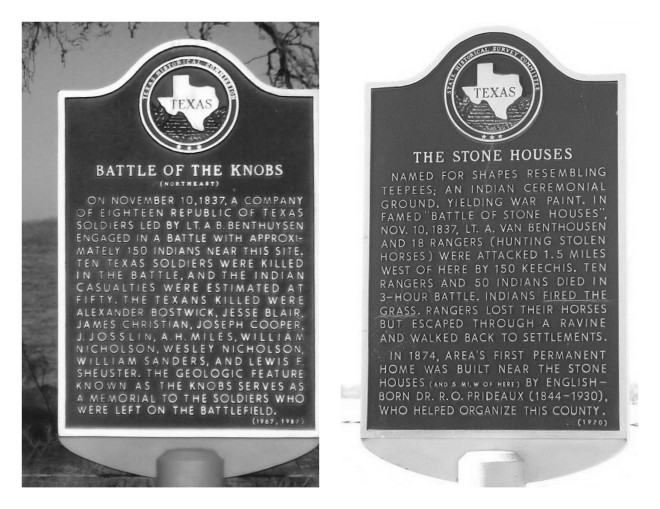This battle took place in late 1837 in North Texas involving a group of Texas Rangers and a number of mostly Keeci Indians. According to the various accounts, a Lt. Van Benthuysen was searching the area looking for some stolen horses. After several weeks of scouting, the Rangers encountered the Keeci (also spelled as Kichai and Keechi) at a place known for its appearance, mounds of rock described as rock teepees or rock houses. According to all accounts, the Keeci outnumbered the Rangers several times over, with the Indians amounting to an estimated 150 and the Rangers numbering seventeen or eighteen. The Rangers held out after losing four of their party. Also during the battle, the Indians set off a ring of fire around the troops who escaped on foot through the smoke, but not until having lost ten men, over half their number. Out of their eighteen, four were killed in the battle and six were killed during the escape. They walked and foraged for ten days until reaching a friendly Kickapoo camp near the present city of Dallas where they stayed for a while before returning to safety near Houston.
The battle is noted in several different books and other accounts, with most of the key facts presented being in agreement. Some accounts predate the battle with more details, having the group involved in the battle having split off from a larger group commanded by Captain William Eastland. Several accounts add that early on, a Keeci chief was killed by rifle fire leading the Indian force to regroup under another leader.
The sources for these accounts include the editions of Walter Prescott Webb’s 1935 edition of his book called The Texas Rangers, and J. W. Wilbarger’s account called Indian Depredations in Texas. Additional accounts may also be found under each of the battle names shown in this article’s title. Curiously, two different Texas historical markers appear to commemorate this event. They are actually in different counties, Wise and Archer, which are not adjacent to one another and are separated by Jack County.
The Wise County marker calls the event the Battle of the Knobs and places it off Old Decatur Road north of Decatur on a marker that was first set in 1967. The Archer City marker calls it the Stone Houses and places it southeast of Archer City on a marker that bears a date of 1970. The text of each marker is fairly similar and appear to refer to the Ranger forces being led by the same individual, Van Benthuysen (Wise County) or Van Benthousen (Archer County). The Wise County marker doesn’t name the Indians by tribe whereas the Archer County marker references the Indians as being Keechis. Both give the date of the battle as November 10, 1837. The Wise County marker names the Ranger dead, while the Archer County marker references the burning of the prairie. The markers are shown side by side below.

(Image credit: (left) Wise County Historical Society, (right) Findagrave)
We have not come across this particular situation before and at this point do not know why there are two markers for what appears to be the same event. If we are ever able to find a better explanation for the existence of the two markers, we will post the information here as an addendum.
Stephen L. Moore’s book Savage Frontier, 1835-1837: Rangers, Riflemen, and Indian Wars in Texas seems to place the battle south of the West Fork of the Trinity River which flows from Clay to Montague, to Wise, to Tarrant and finally to Dallas County, but does not flow through Archer County. This favors the Wise County location for the battle. Author Moore also refers to the event as the Battle of the Stone Houses, and The Stone Houses is the heading for the Archer County marker.
Benthuyson is thought to have died in 1888 in Tuscon, Pima County, Arizona, of a stomach ailment. His burial place is unknown. Captain Eastland mentioned in the account was William Mosby Eastland (1809-1843) who was also the officer executed in 1843 in the “Black Bean incident” under the orders of Santa Anna, after having been captured in the Mier Expedition. His remains were recovered five years later and returned to be interred in La Grange, Texas. Eastland County is named for him and since the community of Eastland apparently took its name for the county, it is indirectly named for him as well.
Special thanks: Bob Dunn
© 2018, all rights reserved.

These are two separate incidents, not the same incident reported twice.
LikeLiked by 1 person
Thanks for the comment. I tried to verify that, but have not yet been able to.
LikeLike